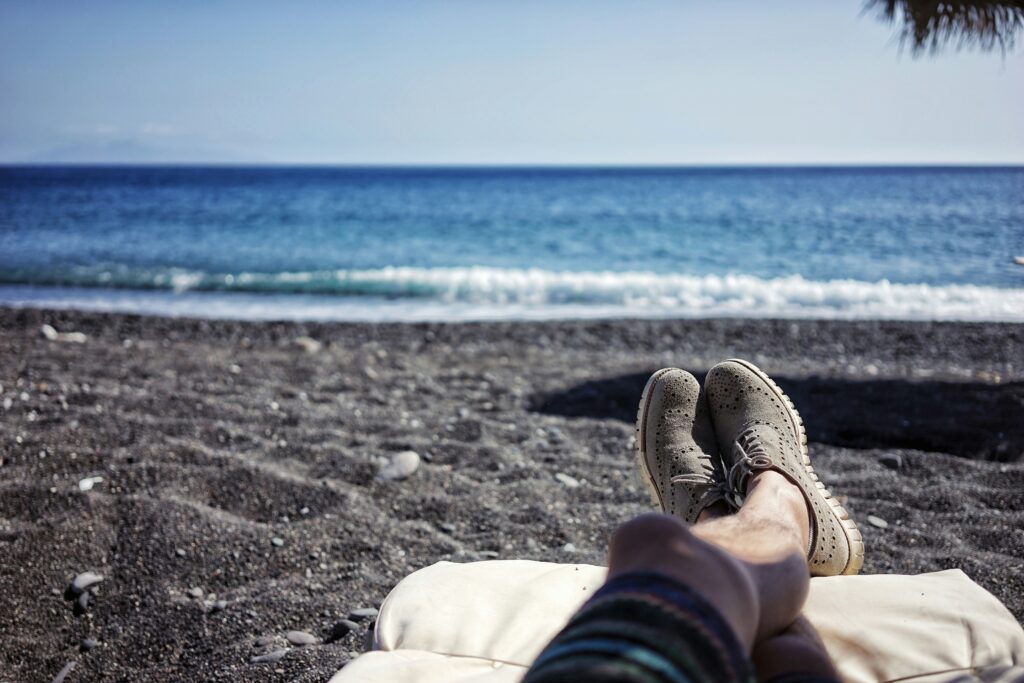Finding relief from anxiety can be challenging, but there are tools available to you that can make a significant difference for you in combination with psychotherapy or alone. Here is a self-help guide for anxiety relief, including specific exercises and lifestyle adjustments. Some of these are to provide quick relief while others are focused on sustained lifestyle changes.
Exercises for Quick Anxiety Relief
Take a Deep Breath – Deep Breathing Exercise
When we feel anxious, our breathing rate naturally speeds up as part of our body’s fight-or-flight response to a perceived threat. However, if our breathing quickens without any physical activity, we end up exhaling too much carbon dioxide. If our body can’t quickly bring carbon dioxide levels back to normal, we might start to feel dizzy, have headaches, feel weak, or even experience tingling in our hands and feet, along with muscle stiffness.
Did you know that the normal breathing rate is about 10 to 14 breaths per minute? Consistently overbreathing can leave you feeling drained or “on edge.” This can make you more likely to react to stress with heightened anxiety and panic. Taking control of your breathing will help you get relaxed.
Here’s the Deep Breathing Exercise in a few simple steps:
- Get Comfortable: Sit in a comfortable chair or lie down on your bed.
- Inhale: Take a deep breath in for 4 seconds (try to breathe in through your nose).
- Hold: Keep that breath for about 2-3 seconds.
- Exhale: Slowly breathe out for 6 seconds, again through your nose. Take a little pause before you breathe in again.
Repeat for 2-3 minutes. Even 1 minute of deep breathing exercise might help you relax.
Tips:
- Start Slow:If breathing in for 4 seconds feels tough, you can start with a 3-second inhale, a 1-second hold, and a 4-second exhale.
- Breathe with Your Belly: Make sure you’re breathing with your stomach, not your chest. You can check this by putting one hand on your stomach and the other on your chest. Your stomach should rise when you breathe in.
- Find Time to Practice: Try to practice this once or twice a day when you can relax and won’t be distracted. This helps build a calm breathing habit. Remember, practice makes perfect, so set aside a little time each day!
Relax Your Muscles – Progressive Muscle Relaxation Exercise
This exercise involves tensing and relaxing different muscle groups to reduce physical tension caused by anxiety.
First, find a private and quiet place. You may sit or lie down, just make sure that it is somewhere comfortable.
Start practicing with your feet.
- Tense the muscles in your toes by curling them into your foot. Notice how it feels when your foot is tense. Hold the tension for 5 seconds.
- Release the tension from your toes. Let them relax. Notice how your toes feel differently after you release the tension.
- Tense the muscles all throughout your calf. Hold it for 5 seconds. Notice how the feeling of tension in your leg feels.
- Release the tension from your calf, and notice how the feeling of relaxation differs.
Follow this pattern of tensing and releasing tension all throughout your body. After you finish with your feet and legs, move up through your torso, arms, hands, neck, and head.
Visualize Your Peaceful Place

This exercise involves imagining a scene in which you feel at peace, letting go of all tension and anxiety. Choose whatever setting is most calming to you and imagine it with all details that you can experience with your 5 senses. Here is an example with a scene at the beach:
- Sight: The sun is setting, casting beautiful colors of pink and orange across the sky. The soft sand is golden, and small shells are scattered along the shore.
- Sound: You hear the gentle sound of waves rolling in and out, along with the distant laughter of kids playing.
- Touch: The warm sand feels nice under your feet, and the cool water gently splashes against your ankles.
- Taste: You enjoy a sip of cold lemonade, refreshing and sweet on your tongue.
- Smell: The air is filled with the fresh scent of saltwater and sunscreen, making you feel relaxed and at ease.
You may try using podcasts or audio guides as well for visualizing such a place.
Ground Yourself in the Present Moment and Your Environment
Grounding exercises help alleviate anxiety through reconnecting you with the present moment and diverting your attention from distressing thoughts or feelings. By focusing on physical sensations and the immediate environment, the below grounding practice can interrupt the cycle of anxious thoughts and the flooding of overwhelming feelings.
The 5-4-3-2-1 exercise involves using your senses to connect with your surroundings.
- Identify 5 things you can see (e.g., a tree, a picture on the wall).
- Identify 4 things you can touch (e.g., the texture of your clothes, the ground beneath you).
- Identify 3 things you can hear (e.g., birds chirping, traffic sounds).
- Identify 2 things you can smell (e.g., fresh coffee, flowers).
- Identify 1 thing you can taste (e.g., a sip of water, a piece of gum).
Other practices of grounding might be:
- Through breathing: As described in the above exercise.
- Through your body: Lie on the ground, put your feet on the ground, hug something soft and fluffy, squeeze a toy or play dough.
- Through observation: Describe an object in detail—color, texture, size, shape, weight.
- Through distraction: Count by 8s, find the blue objects in the room, find the square objects in the room.
These techniques help to reconnect with the present and relieve stress.
Lifestyle Strategies for Anxiety Relief
These are some key lifestyle strategies that can help reduce anxiety over time.
1. Introduce Mindfulness Exercises into Your Life on a Regular Basis
Mindfulness exercises on breathing, body scan, and self-compassion you may find online or through apps can help calm your nervous system and focus on the present moment, breaking the cycle of the daily rush and the continuous worrying.
2. Keep a Journal
Writing down about the situations and things that make you anxious can help you identify your thinking and behavior patterns that sustain your anxiety so that you may first understand and then actively challenge them, developing alternative views of those. A good example is to think about it as if it happened to a friend of yours and they asked your opinion.
Don’t miss out on writing down what makes you feel good and grateful as well so that you don’t get stuck in your worries. The positive experiences will also help you identify what will help you feel better in times of intense emotions.
3. Move Your Body
Incorporate regular exercise and movement in your life. Exercises like yoga, stretching, walking, running can relieve anxiety and anxiety-induced muscle tension. Dancing to your favorite music is another great way.
4. Enhance your routine
Stay hydrated, eat regular and balanced meals, rich in vitamins and minerals. Keep in mind that high sugar or caffeine intake can exacerbate anxiety and cause mood swings.
Watch out for your alcohol intake. Alcohol consumption has a complex relationship with anxiety. Initially, it may provide temporary relief by reducing self-consciousness and promoting relaxation. However, excessive or chronic alcohol intake can lead to increased anxiety over time, as it disrupts brain chemistry, affects sleep quality, and can lead to dependency.
Establish a regular sleep routine and create a calm sleep environment. Refrain from engaging with TV, video games, or social media right before bedtime or in bed as they overstimulate your brain instead of calming it down. Aromatherapy with essential oils that have soothing and relaxing qualities, like lavender, might also help.
Sexual activity provides anxiety relief by releasing endorphins, fostering emotional connection and improving self-esteem.
Spending time in nature, outdoors, particularly in green spaces or by the sea can enhance feelings of tranquility and have a calming effect.
5. Engage in Creative, Expressive, Playful Activity of Your Preference

Drawing, painting, writing, photography, pottery, playing an instrument, knitting, sewing, or any other form of artistic expression can enable you to externalize your emotions and also have a self-soothing effect. Dancing can help you relieve built-up anxiety, and listening to calm music may alleviate your anxiety.
Engaging in playful activities like coloring, crosswords, sudoku, or puzzle games can take your mind off anxious thoughts and give you the pleasure of achievement. For some people, household chores like cooking, tidying, ironing, or cleaning can also be anxiety relieving. Playing with kids or pets can significantly alleviate anxiety by promoting feelings of joy and connection.
6. Put Limits to Your Digital Exposure
Beware that excessive screen time can increase anxiety, especially through exposure to negative news from all around the world or engaging in social media interactions for long hours. Keep in mind that continuous exposure to certain influencers you follow can elevate your anxiety by promoting unrealistic standards and lifestyles, leading you to constantly compare yourself and pressurize you to conform. Additionally, the fear of missing out on things, events, experiences can exacerbate your feelings of inadequacy, and the pursuit of validation through likes, comments, and shares can lead to anxiety when engagement is low.
In our world today, we’re constantly surrounded by digital media. You may find that limiting the time you spend on social media, news, or email reduces the anxiety you feel. Unplugging can allow you to engage more with the physical world around you. Benefit from your device’s limit setting functions or you yourself schedule “no-screen” hours. It may even help to leave your phone in another room while you engage in other activities.
The importance of psychotherapy
While self-help strategies can provide immediate relief and empower you to take control of your mental health, psychotherapy offers unique benefits that enhance your journey. In the case of anxiety disorders, existential-Integrative psychotherapy combines approaches of symptom alleviation in the short-term and deeper exploration of the underlying existential conflicts in the long term. It prioritizes addressing your immediate symptoms as you would need support to develop some ways of managing your anxiety symptoms before we can address the underlying existential conflicts.
In our sessions, together, we may identify which combination of the above strategies will work best for you. I may guide you through different exercises during sessions or recommend these and some others for you to practice in between sessions. During our sessions, we will explore underlying issues that may be fueling your anxiety.
Some common existential issues that can be the source of your anxiety are:
- absence of meaning & purpose in life
- difficulty in accepting inevitable loss, which may be actual or anticipated, concerning loved ones, one’s health, status, money, identity but also one’s opportunities/dreams
- conflicts arising from one’s ability to choose and the responsibilities that come with those choices
- conflicts arising from one’s giving up on their autonomy and/or authenticity to secure relationships, status, financial gain
- difficulty in tolerating painful emotional experiences (rage, helplessness, humiliation, despair, guilt)
- conflicts between the desire of being free, autonomous and the desire of connection and intimacy.
Understanding these issues can help you explore your anxiety more deeply and find long-term relief from it.
These existential themes can create an intense sense of anxiety when not addressed and might manifest even in panic symptoms. We will look into your thoughts, beliefs, emotions and behaviors that trigger and maintain your anxiety symptoms. Identifying these will help you to understand what contributes to your anxiety and eventually keep you from confronting deeper conflicts.
The therapy will gradually shift to exploring and understanding the deeper, existential issues, underlying your symptoms. This latter phase involves helping you face and work through the underlying main existential conflict, eventually reaching a resolution and enabling you a more satisfactory engagement with life.

